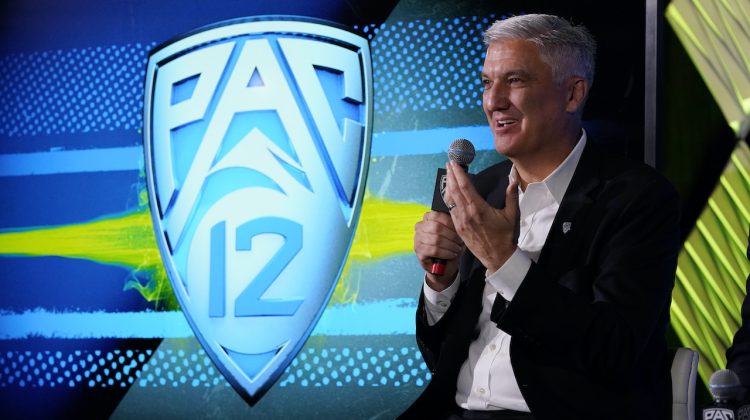By Jon Wilner
Long before the Pac-12’s legal dispute, before the collapse and the Comcast scandal and even before the Los Angeles schools fled for a greener pasture, commissioner George Kliavkoff decided to shutter the conference office and relocate the Pac-12 Networks’ production studio.
Kliavkoff eventually settled on office space in the East Bay city of San Ramon. The conference declined to disclose contract terms but said the move would save millions of dollars per year in rent.
For some, the timing was curious. Kliavkoff committed to a multi-year lease on 42,000 square feet that began this summer — before he had secured a media rights deal that would keep the conference together.
All these months later, the Pac-12 has imploded, 10 schools are leaving, two have been left behind and everyone is seeking clarity on the Pac-12’s assets and liabilities.
Is the San Ramon production facility the former or latter? At the very least, it stands as one of the most confounding aspects of this tumultuous stretch.
Many details are not publicly known, including the endgame. But the Hotline has a few answers.
Why move in the first place?
Few issues have frustrated the campuses over the years like the lavish spending at the conference office, and that spending starts with the office itself.
The Pac-12 paid millions of dollars annually for two floors of office space in downtown San Francisco: One floor for conference operations; one for the Pac-12 Networks studios.
The optics were terrible, the rent was worse — the total outlay over 12 years exceeded $90 million — and the pressure on Kliavkoff to solve the problem was immense.
He made reducing conference expenses in general, and relocating the headquarters specifically, a centerpiece of his agenda upon being named commissioner in the spring of 2021.
“He was so eager to get out of San Francisco,” a source said, “that he pushed for a move fast.”
Why move in 2023?
In one crucial regard, Kliavkoff had no choice. While examining the Pac-12’s contract with Kilroy Realty during his early months in office, Kliavkoff was stunned to discover the deal expired in the summer of 2023 — one year before the end of the Pac-12 Networks’ distribution contracts with Comcast, DISH, etc.
He wasn’t alone. Campus officials and conference staffers alike were baffled when they learned that former commissioner Larry Scott had agreed to the one-year contractual offset.
Why not align the lease with the media deals?
“It’s insanity,” one source said.
“We were gobsmacked,” another said. “Nobody knew it. And nobody could figure out why Larry would agree to an 11-year building lease for a 12-year TV deal.”
One industry source speculated it could have been a leverage play.
“Typically, you don’t have big contracts expire at the same time because it can provide leverage to the other side,” the source said. “So you might do a renewal of the lease but make it contingent on the (media) rights deals.”
There was no contingency clause in the Pac-12 deal, according to a source.
Scott did not immediately respond to a request for comment.
Why not extend the deal in San Francisco?
Whatever the reason for the contractual offset, the reality was bearing down on Kliavkoff in early 2022: The Pac-12 had to either renew in San Francisco or commit to finding an alternate location for the networks’ production studio.
According to multiple sources, the lease included an option to renew for one or more years at market rates. After a series of negotiations, it became clear that any extension would have doubled the $7.3 million annual occupancy cost the conference paid in 2022.
Given the price tag, Kliavkoff committed in March 2022 — with approval from the university presidents — to move out of San Francisco and find office space for the Pac-12 Networks production studio.
“George said, ‘There’s no decision to be made,’’’ a source said.
The cost of San Ramon
Three months later, USC and UCLA announced they were leaving for the Big Ten, and the Pac-12’s future turned murky.
Ever the optimist, Kliavkof plowed forward with plans to relocate. In January, the conference selected Bishop Ranch, a 600-acre, mixed-use community in the city of San Ramon.
The conference has declined to provide contract terms, but multiple sources believe Kliavkoff signed a four- or five-year lease in the range of $1.5 million to $2 million annually.
Then the expenses began piling up.
The San Francisco lease required the conference to return the two-story office space to its original form as two single-floor offices, a “significant” cost, according to a source.
Inflation and supply-chain issues pressured the transition budget. So did the cost of delivering a fully-functional production studio on an expedited timeline.
Multiple sources said the project went over budget. To offset the costs, the presidents approved tapping the emergency reserve funds that were available at the time, sources said.
The facility opened in July to positive reviews. But weeks later, the conference collapsed and the Pac-12 was left with at least three more years in San Ramon at $1.5 million (or more) annually.
Options for San Ramon
That said, it’s too soon to place the San Ramon office in the liabilities column.
In fact, one source described the facility, which has state-of-the-art technology and is located in the Bishop Ranch business park, as a valuable asset starting next summer.
If Washington State and Oregon State opt to rebuild the conference, the production studio could be used to broadcast their events.
Perhaps a media company (hello, Apple) would be interested in subleasing the space and equipment. Or buying it outright.
Maybe the infrastructure could be used by the Mountain West conference in its next media contract cycle (2026) following a merger with Washington State and Oregon State.
Perhaps the schools headed to the ACC (Stanford and Cal) and the Big 12 (Arizona, ASU, Colorado and Utah) could use the facility to produce events for their new leagues, which have digital media elements within their contracts.
As with so much else about the Pac-12, the future of the San Ramon production facility is complicated, and undetermined.
*** Send suggestions, comments and tips (confidentiality guaranteed) to pac12hotline@bayareanewsgroup.com or call 408-920-5716
*** Follow me on Twitter: @WilnerHotline
*** Pac-12 Hotline is not endorsed or sponsored by the Pac-12 Conference, and the views expressed herein do not necessarily reflect the views of the Conference.
Related posts:
 Pac-12 need-to-knows: Trap games and Power Five foes highlight Week Two lineup
Pac-12 need-to-knows: Trap games and Power Five foes highlight Week Two lineup 
(AP Photo/Ralph Freso, File)
Pac-12 survival: Kliavkoff on media rights timeline, Big 12 and Big Ten threats, playoff expansion and UCLA’s move Pac-12 media rights: University presidents issue statement of unity as process churns on
Pac-12 media rights: University presidents issue statement of unity as process churns on  Pac-12 media rights: Arizona president Robert Robbins says “competitive” deal necessary for schools to stick together
Pac-12 media rights: Arizona president Robert Robbins says “competitive” deal necessary for schools to stick together
